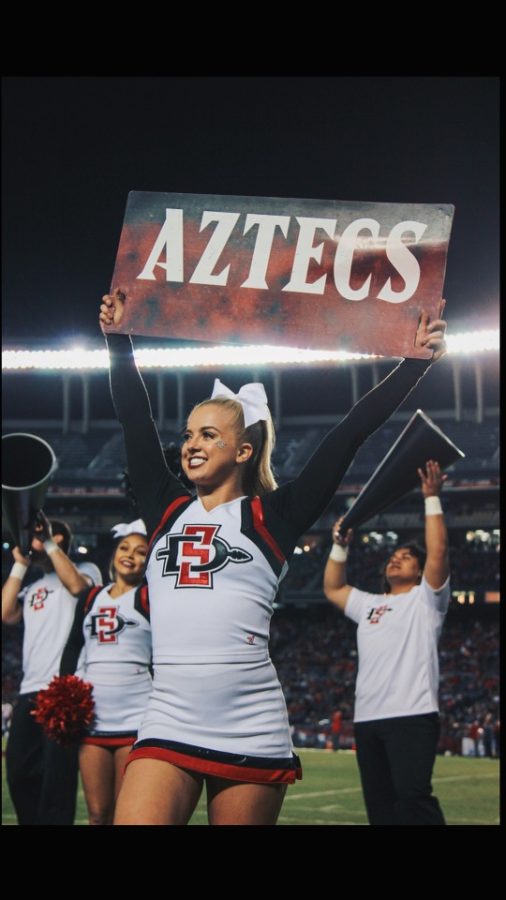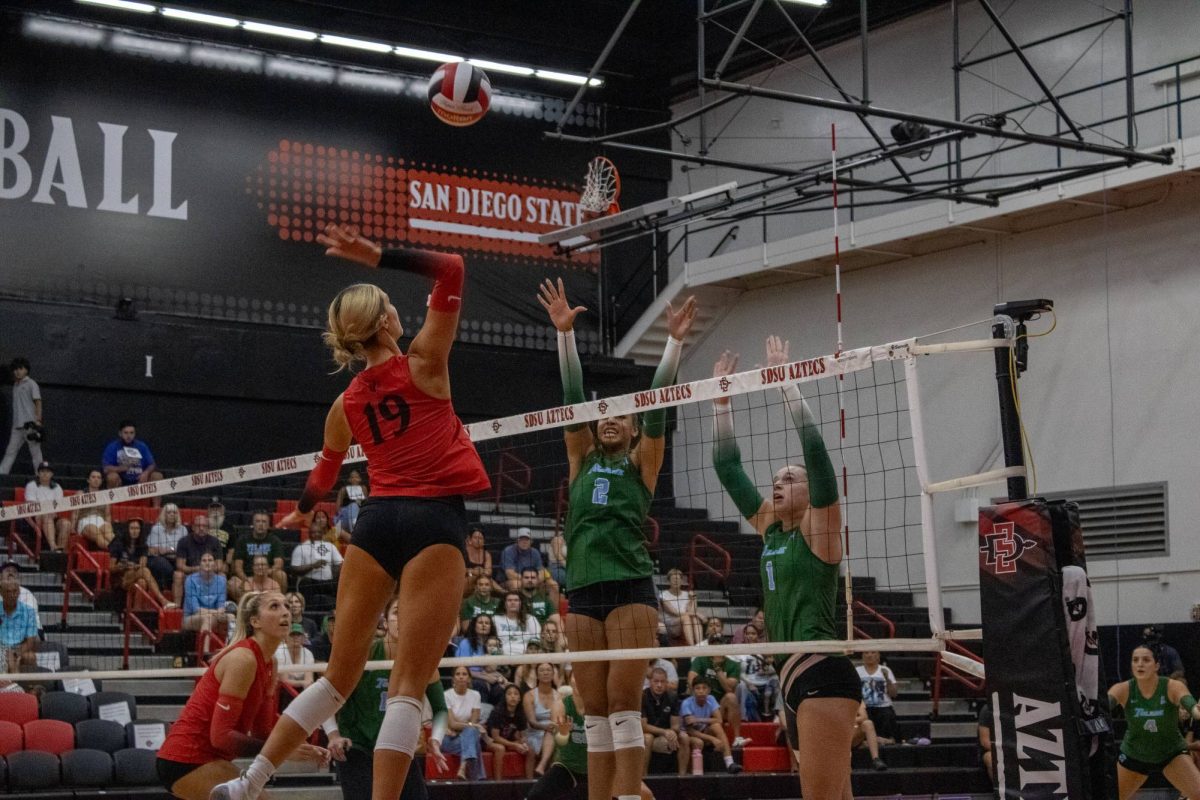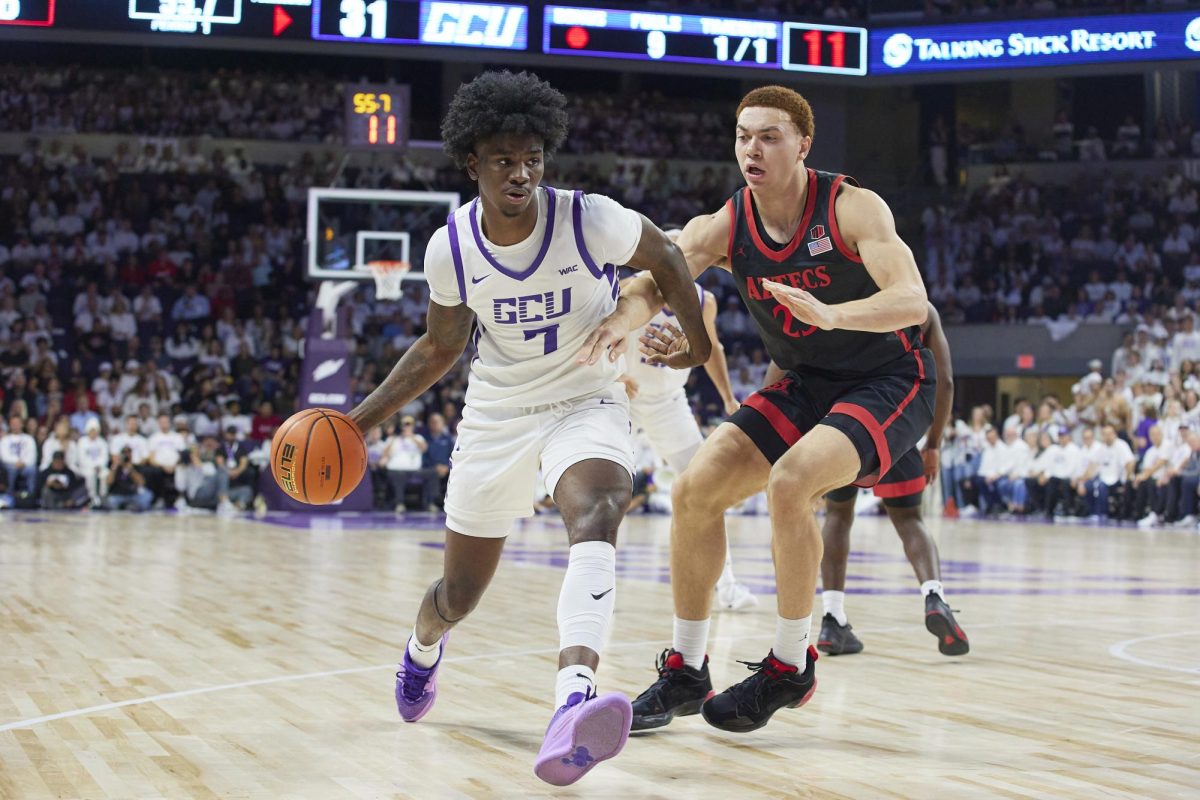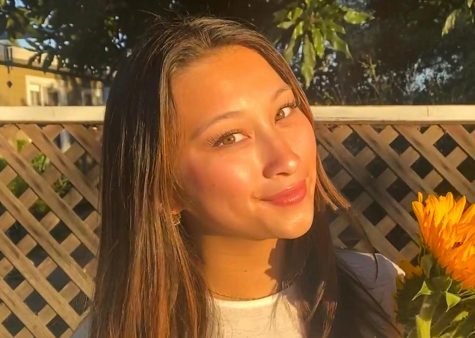Waking up at 2 a.m. to do hair and makeup, senior Megan Hooks needed to leave by 3:30 a.m. to make her 6 a.m. call-time to cheer on the San Diego State football team in Carson, California. After cheering for four hours in the blazing sun, Hooks had a quick break before driving to Anaheim to cheer on the SDSU basketball team against the University of Southern California on Nov. 26. By 1:30 a.m., she was heading back to San Diego after almost 24 hours of travel and cheer.
Hooks is a fourth-year cheerleader and business marketing student at SDSU. She is part of the Weber Honors College and is also minoring in interdisciplinary studies. Hooks has been a cheerleader at SDSU for the four years she has been attending, in addition to cheering for a decade prior.
After graduating high school, Hooks already knew she wanted to pursue cheerleading in college. Considering that SDSU has a well-known cheer program nationally, it was “an obvious choice” when she made the team. Since she had already been balancing her schoolwork and being on two cheer teams in high school, she said felt prepared to take on the collegiate student athlete lifestyle.
How does one manage work, school, a social life, and being an athlete? Hooks explained how she balances her life by managing her time and staying organized.
“It’s definitely a time thing,” Hooks said. “I try to make time for things I care about but there’s only a certain number of hours in the day.”
First, school is always a priority to her. Then, comes cheer, work, friends, and anything else. Hooks said she’s even ran down the street to her house from campus to quickly change and go to work. She said staying organized is the key to managing her time. By having spreadsheets and calendars, she can keep track of her school, work, social, and cheer schedule.
Hooks’ roommate and friend, senior Lizzie Kridle, gave an inside look on living with a student athlete.
“From living with Megan, I think I have learned a lot about time management and prioritizing things and relationships that are important to you,” Kridle said. “I am always impressed with the amount of tasks, meetings, classes, and practices that Meg is able to get through in a day.”
Cheer practices are three times a week with weightlifting on the same days. Hooks said making time for practice isn’t too bad, but games and events are far more demanding. Games are mandatory for SDSU cheerleaders and events are voluntary on a point-based system. The more events you attend, the more points you get toward getting to travel with the team. Football games are once a week while basketball has one or two a week. Events occur the most, being up to three times per week. Events include on-campus activities, sports games, and even community related gatherings. Homecoming events, new students’ convocation, volleyball and soccer games, blood drives, and news station promotions are just a few examples of events.
Hooks said she struggles with not getting the same respect for being a cheerleader that other athletes get. University Press elaborates on this in their article “The Everyday Life of a Cheerleader.” The National Collegiate Athletic Association does not consider cheerleading to be a sport, so college cheerleaders do not get as many benefits as other collegiate athletes. These benefits include tutors, scholarships, specialized doctors, and priority registration. By not having priority registration to work around practice times, the SDSU cheerleading team has to practice as late as 11 p.m. on weekdays. Hooks shared how although they sideline cheer for other sports, the cheer team has their own events and competitions as well. Their competitions aren’t publicized as much as other sports, and many other athletes don’t see the extent of what they do.
Being a cheerleader and a student means that Hooks has had to make some compromises.
“Socially, I’m not as involved in things because I’m so involved in cheer,” Hooks said.
Her freshman and sophomore year she often couldn’t hang out with her roommates because of her cheer schedule. Eventually, they became close while she was busy with school and cheer. However, these past two years she became more adapted to her busy schedule and was able to balance her social time.
Even as a senior, she said she’s constantly “on the go” while her friends can enjoy living in San Diego more.
“She always has her door open for any of the housemates to come into her room and chat,” Kridle said. “I think this just embodies how open and friendly she is, which can probably be attributed to always being a reliable teammate from being involved in cheer for so many years.”
Hooks was quick to mention her dependence on her teammates whenever her schedule becomes overbearing. Collectively as a team, they all face similar struggles. Many of her teammates have had to leave the team or ended up not trying out again the next season.
“We’re all going through it together,” Hooks said. “If I’m stressed, I can always lean on them.”
Although being a student athlete can be challenging at times, Hooks has learned a lot from balancing school and cheer. Not only have her time management skills helped her in college, but they will be beneficial to her life and career after graduation. In addition, Hooks has become more motivated and goal oriented.
“I’m more motivated,” Hooks said. “I have goals in school and cheer and am trying to accomplish all of them.”
After graduating this May, Hooks will end her SDSU cheerleading career. There are not many opportunities for her to pursue cheer after college because professional cheerleading is mainly dance oriented. After over a decade of cheer, Hooks said she feels it might be the right time to say goodbye to her sport.
“It’s bittersweet. I think I’m ready to be done, physically, my body is done,” Hooks said. “But just because I’ve been doing it for so long, it’ll be sad.”









